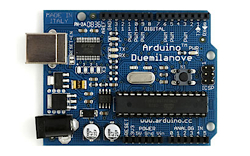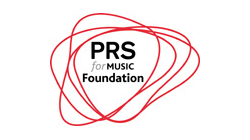Make It Yourself – Selected Works
    | Cybersonica with Openlab Workshops and Manchester Art Gallery present:
Make It Yourself is an exhibition of inventive Arduino and DIY electronic-circuitry projects to accompany the major solo exhibition Recorders by Rafael Lozano-Hemmer – see http://bit.ly/9WLZCJ for more information – at Manchester Art Gallery between 18 September 2010 to 30 January 2011. A rapidly expanding community of people worldwide is taking advantage of new, cheaper technology and a growing pool of shared knowledge to make things for themselves – useful things, clever things, silly things, unique things. Make It Yourself is a ‘small but perfectly formed’ show of a handpicked half-dozen of these hand-made devices. Rafael Lozano-Hemmer: Recorders and Make it Yourself are supported by Arts Council England. Cybersonica’s contribution to Make It Yourself is supported by the PRS Foundation – www.prsformusicfoundation.com.
The Make It Yourself works are now (almost) all on display in the Resource Room, 2nd Floor, Manchester Art Gallery, Mosley Street, Manchester UK M2 3JL. For details about the artists and works – including ‘How To Guides’ (where available) Artist: Mike Blow
Artistic Statement: The Theremuino is an infra-red theremin (distance-activated musical instrument) based on an arduino microcontroller. The player’s right hand controls notes on and off using an arcade button, whilst the left hand controls the pitch by moving nearer and further from an infra red sensor. The Theremuino has two modes; “polite” which sounds quite musical, and “rude” which sounds more harsh, electronic, and rhythmic.
Artist Biography: Blow is a sound artist and arts technologist currently undertaking PhD research in the Sonic Art Unit at Oxford Brookes University. Blow’s solo work is concerned with the relationship between sound, space and the imaginary. Blow is interested in the presentation of sound as a medium, its relationship to physical and non-physical objects, and its power to engage audiences in an emotional way through memory or by evocation.
Artist: Chris Gladwin
Artistic Statement: Potato Synthesis is part of Gladwin’s collection of experiments to camera entitled “Paramusical Sound Studies with Video”. This series works to explore the aesthetic of noise produced by crude sound generating devices or actions, hacked redundant technologies and environmental interventions. In this piece the potato (raw or mashed) acts as a connector for a power circuit, resulting in the generation of a continuous stream of electronic noise.
Artist Biography: Christopher Gladwin is an experimental musician, noise maker and sound artist. The spawn of early computer games, 80’s video nasties and his parent’s Prog Rock collection, he began making electronic music from his bedroom studio in the late 90’s. He went on to study at the Hull School of Art & Design exploring the interface between music and contemporary art, and became involved in the city’s vibrant avant-garde underground. Chris is mainly known for his electronica output under the name of Team Doyobi with long time collaborator Alex Peverett. The Team are considered by some to be the godfathers of the UK Chip Tune scene and their discography features labels such as Skam, Staalpaat, Tiger Beat and Fatcat records. Together with this project Chris also works under a number of aliases (The Wyrding Module, Dr Derek F. Livet Er Smerte) and when the opportunity arises will get involved in improvised performances with whoever and whatever (at one gig he played an amplified bowl of couscous). His creations can embrace pop musicality or the absurdist noise of his more outré sonic research; previously he has recorded the screams of frogs and performed 340 songs in one set.
Artist: Doug Jackson
Artistic Statement: Jackson was inspired to make this work after reading a newspaper article about the 2007 Boston bomb scare, which occurred when police mistakenly identified small electronic devices branded with an LED image of a cartoon character, a “Mooninite”, found throughout Boston as part of a Guerrilla marketing campaign, as improvised explosive devices. Jackson states: “I saw the sad state of affairs that an unhealthy mixture of paranoia, enthusiastic media, and over-zealous police response can create. On that day, a simple advertising campaign turned sour and shook the city of Boston. Prior to this day, we here in Australia had not even heard about Moonitites, or the Adult Swim Channel. Once the Boston Police did what they did best, the whole world knew…
The stupidity of the event shocked me, so I decided to make my own small scale version to remind my children that problems should be solved – not simply blown up! Call this my own personal protest! In all my design work, I attempt to empower others in beginning their own creative journeys. I have re-created my own impression of the Moonitite display using my own non-infringing cartoon character.” Artist Biography: Doug Jackson is a 43 year old Information Security Consultant by day, and a retro electronics hobbyist by night. His traineeship with the Australian National University in the late 1980’s provided a firm background in Digital Electronics that he uses to this day to make small projects that he otherwise couldn’t justify purchasing. He also has a significant background in teaching electronics and programming at Bruce T.A.F.E College, allowing him to satisfy his desire to help others understand the fun that is inherent behind making things with your own hands. When not making electronics projects, he loves to teach 7 – 10 year old Cub Scouts the fine arts of canoeing, sailing, and achieving goals that initially appear unachievable. Artist: Andrew O’Malley
Artistic Statement: DOTKLOK is an open source, digital clock kit with multiple time-telling animations, some literal, and others showing the passage of time through abstract patterns. The motivation for this clock is to combine in a single device a variety of existing ways to show time — such as in a sentence, with words, or retro game displays — alongside my own original animations, while providing a platform on which others can further develop unique timepieces.
Artist Biography: Andrew O’Malley is a Canadian new media artist with a formal background in electrical engineering. While also engaged in painting, audio, and video practices, it is sculptural lighting which draws the focus of his creative energy. His work has been supported by the Ontario Arts Council, the City of Ottawa, and the Corel Endowment Fund for the Arts. He has exhibited widely in Ontario, and is currently the president of Ottawa artist run centre, Artengine, dedicated to electronic art and its evolving relationship with society. He is also involved with New York based art/technology centres NYC Resistor and Eyebeam. O’Malley also works collaboratively with his wife, Deborah, as an audio/video performance duo, in this guise and for other artistic projects the couple go by the name The Latest Artists. Artist: Sergey Teterin
Artistic Statement: Poetophone is an original art device, constructed using an old Soviet design telephone and MP3 technology. Poetophone was created as a device to represent the astral connection with the Russian futurist poets, David Burliuk, Vladimir Mayakovsky, Aleksey Kruchenykh and Vasily Kamensky. When the user lifts the receiver and presses a button to make a call they will instead hear one of twelve speeches from these poets including Kamensky’s “Nightingale” (1916), Kruchenykh’s “Roman on Telephone” (1951) and Mayakovsky’s “Navy Love” (1920).
Artist Biography: Sergey Teterin (b. 1969) is a Russian media artist and has exhibited work in numerous international media art exhibitions and festivals. Teterin has also previously directed the 2002 Read_Me 1.2 Software Art Festival and the 2003 and 2004 Machinista Media Art Festival. Currently, in addition to his artistic practice, Teterin works as promoter and art manager for CYLAND Media Art Lab, Saint-Petersburg, Russia. CYLAND is an artistic laboratory created by the St. Petersburg branch of the Russian National Center for Contemporary Art in cooperation with the St. Petersburg Arts Project Fund, New York, for artists who practice using new technologies in an artistic way. Artist: Rutger van Wielink
Artistic Statement: Van Wielink initially got the idea of turning an old popcorn roaster into a coffee bean roaster off the internet, and whilst the coffee beans roasted successfully (and tasted really nice!) it was a very laborious process with a lot of room for variation as the temperature needed to be controlled by hand. As a result, van Wielink decided to create a new version of the device using arduino. The latest version of the device now measures the temperature of the beans and adjusts the temperature by increasing or decreasing the speed of the ventilator that blows hot air through the beans. The controller then follows a preset temperature profile and automatically cools the beans at the end.
Artist Biography: Van Wielink is a PhD student in biotechnology and had never used hardware electronics before discovering Arduino. Van Wielink was immediately inspired by arduino due to its potential for creativity, with van Wielink feeling that he could now invent anything without being experienced in electronics or micro processors. Once mastering the basic functions of arduino the coffee roaster is van Wielink’s first project using the technology.
Artist: Moris Zen
Artistic Statement: “I work in making one million dollar microscopes and thought it would be cool to make the cheapest digital microscope in the world…” Zen’s work “Build a USB Digital Microscope in 60min and 15$” uses a basic 10$ microscope and 5$ USB webcam to make a cheap digital microscope through which images from the microscope can be viewed on a computer. I am currently working in a high-tech company developing inspection solutions for chip manufacturers. I’ve had a hobby of electronics and gadgets since I was in the 9th grade keeping it going on a low flame for years. |







